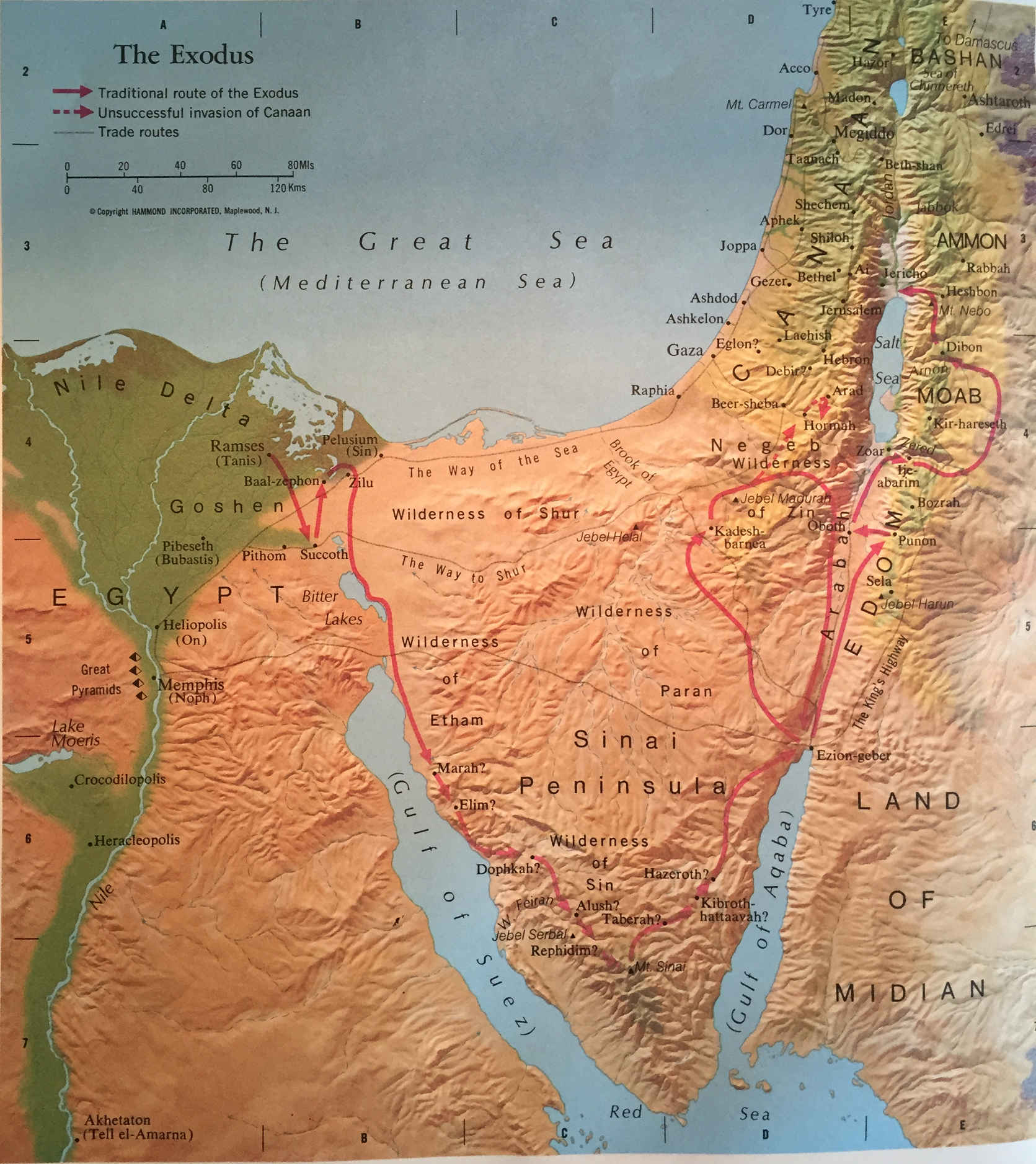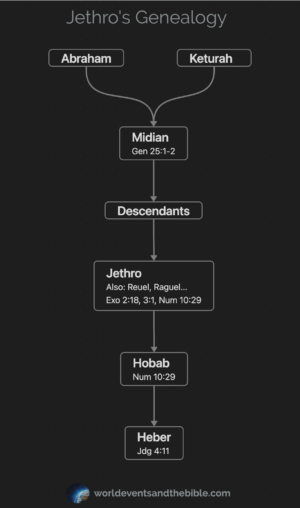Name: Virginia
Question: Was Moses’ father in law a Kenite or simply lived among them?
Answer: Virginia, thank you for the question.
We are going to learn, Moses’ father in law was Jethro. Jethro was a Midianite Priest, this made him a descendant of Abraham, though Jethro lived in the land of the Kenites.
Through careful study, we’ll learn that Jethro’s son, Hobab was a partial Kenite. This understanding will also clear up a misconception in the King James Bible.
The Names Of Moses’ Father In Law
Moses’ father-in-law went by the name of “Reuel” and “Raguel,” which means a “friend of God,” (Exodus 2:18, Numbers 10:29). However, Reuel is more commonly referenced in the Bible by his title of “Jethro,” which means “his excellence.”
The Genealogy Of Jethro
It should be no surprise that Jethro was a “friend of God,” he was a “priest of Midian,” (Exodus 3:1). In order to become a priest of the Midian people, you had to be Midianite by ancestry. Just as all Israelite priests had to be Levites.
Now the word “Midian” means,
“A son of Abraham; also his country and (collectively) his descendants.”
We should understand, the land of Midian was named after one of Abraham’s sons, Midian who went on to establish the Midianite people. We can further prove this in Genesis 25:1-2, where Midian is listed as the son of Abraham and Keturah.
That tells us, Jethro was a Midianite, which makes him a descendent of Abraham, and he “took a burnt offering and sacrifices for God,” (Exodus 18:12). This further proves, Jethro loved our Heavenly Father.
Was Jethro A Kenite?
There’s no question, Jethro was Moses’ father in law, there are seven verses that state as much, (Exo 3:1, 4:18, 18:1-2, 5-6, 12). We know the priest of Midian was Jethro (Reul), and he had seven daughters, Zipporah was one of them, and she married Moses, (Exodus 2:16, 18, 21).
We also know, Hobab was the son of Jethro (Raguel), and Heber was the son of Hobab, making Heber, Jethro’s grandson, (Numbers 10:29). This overview is important to understand.
Now, what I just explained unequivocally proves that Jethro is the father in law of Moses. Unfortunately, there are two Scriptures that seem to contradict that notion. However, we know there are no contradictions in the Bible, so it means we have a little investigative work to do.
In Judges 1:16 and 4:11, there is a mistranslation in the King James Bible. This has been corrected in newer revisions. Let me show you what I’m referring too.
Judges 1:16
And the children of the Kenite, Moses’ father in law, went up out of the city of palm trees with the children of Judah into the wilderness of Judah, which lieth in the south of Arad; and they went and dwelt among the people.
This verse makes it sound like Jethro was a Kenite, since he was the father in law of Moses. However, we know Jethro was a Midianite. So in reality, Jethro is not being discussed, rather his son Hobab, whom Moses invited to travel with the Israelites, (Numbers 10:29).
One more verse, and then I’ll sort this out for you.
Judges 4:11
Now Heber the Kenite, which was of the children of Hobab the father in law of Moses, had severed himself from the Kenites, and pitched his tent unto the plain of Zaanaim, which is by Kedesh.
Once again, the KJV Bible makes it sound like Hobab was the father in law of Moses.
The fact of the matter is, Jethro and his son Hobab cannot both be Moses’ father in law. It’s impossible. So let’s look at the highlighted word “father in law,” to understand what it means in Hebrew.
A primitive root; to give (a daughter) away in marriage; hence (generally) to contract affinity by marriage: – join in affinity, father in law, make marriages, mother in law, son in law.
As we can see, the word doesn’t just mean “father in law.”
Instead, it means “affinity by marriage,” which is any relation by marriage. So it can mean brother in law, son in law, and so on. Therefore, the translators chose to use the word “father in law” in Judges 1:16 and 4:11, not that the Hebrew language required it.
Study and news with a fresh Christian perspective in your inbox.
Therefore, the proper translations would read:
Judges 1:16
And the children of the Kenite [Hobab], Moses’father[brother] in law, went up out of the city of palm trees with the children of Judah into the wilderness of Judah, which lieth in the south of Arad; and they went and dwelt among the people.
And…
Judges 4:11
Now Heber the Kenite, which was of the children of Hobab thefather[brother] in law of Moses, had severed himself from the Kenites, and pitched his tent unto the plain of Zaanaim, which is by Kedesh.
This correction removes the contradiction the King James Bible translators mistakenly introduced, and it helps us understand the true nature of this family and Biblical history. As a reminder, you’ll find these verses properly translated in newer Bible revisions.
The next question that’s swirling around in your mind,
- Since Jethro was a Midiniate, then why is his son called a Kenite?
I’m glad you asked.
We can only presume, but since Hobab was a partial Kenite, then Jethro may have had a wife that was a Kenite. With that, Hobab took on his mother’s tribal affiliation. This is not uncommon in Scripture.
In fact, Caleb is said to be from the tribe of Judah. However, Caleb’s father was a Kenzinite, (Numbers 13:6, 32:12). Ironically enough, the Kenzinites were one of ten nations, along with the Kenites in Genesis 15 that were to be eradicated from the land.
I must say, the possibility of Jethro having a Kenite wife is easy to realize, when we understand where he lived.
Jethro Lived Among The Kenites
When Moses fled from Egypt, he came to live in the land of Midian where he married Zipporah, one of Jethro’s daughters, (Exodus 2:15-21). Moses would tend the flock of Jethro for 40 years, leading them “to the backside of the desert, and came to the mountain of God, even to Horeb,” (Exodus 3:1).
“Horeb” is “a generic name for the Sinaitic mountains.” We are talking about the land of Arabia, the Sinai Peninsula. This provides us with the general region where Jethro and his family lived, among the Amalekites.
Jethro Lived Among The Kenites And Amalekites
God’s Word explains, “the Amalekites dwell in the land of the south,” (Numbers 13:29). The word “south” means, “specifically the Negeb or southern district of Judah, occasionally, Egypt.”
Essentially, the Amalekites occupied the southern portion of land that would later become Judah’s, all the way to Egypt, including the Sinai Peninsula, (1 Samuel 15:7, 27:8). In fact, Exodus 17:8-16 discusses the first war between the Israelites and the Amalekites in Rephidim. This is thought to have been located in the southern portion of the Sinai Peninsula.

Further, 1 Samuel 27:8 explains, “the Amalekites: for those nations were of old the inhabitants of the land.” Naturally, the Scripture is referencing the land of Canaan. So we can see they covered a large portion of land.
This leads us up to the Kenites.
Please turn you Bible with me to,
1 Samuel 15:6
And Saul said unto the Kenites, Go, depart, get you down from among the Amalekites, lest I destroy you with them: for ye shewed kindness to all the children of Israel, when they came up out of Egypt. So the Kenites departed from among the Amalekites.
This verse clearly proves, the Amalekites and the Kenites occupied the same land, the land where Jethro and his family lived. This makes it reasonable to believe, Jethro had a wife who was a Kenite, and Hobab was a child from that marriage.
Summary
We’ve now firmly concluded that Jethro is not only Moses father in law, but he was a Midianite, which means he’s a descendant of Abraham. We discovered, the word “father in law” was mistranslated and with this correction, we now know that Hobab was a partial Kenite.
From there, we can only presume that Jethro had a wife that was a Kenite, and that’s how Hobab took on this ancestral heritage. This makes sense, as Hobab’s son, Heber was also called a Kenite. It was a new branch of Jethro’s family, half Midianite, and half Kenite.
